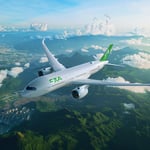Bangkok’s Suvarnabhumi International Airport had a moment to savor on 22 November when Vietjet Thailand welcomed its first Boeing 737-8 — a sleek, fuel-efficient addition that signals the start of a sweeping fleet expansion across the Asia–Pacific. This single arrival is the opening act of an ambitious US$32 billion (1.15 trillion baht) programme, and it’s poised to reshape how the low-cost carrier serves travellers across the region.
A strategic touchdown for Vietjet Thailand
What makes this delivery more than just another aircraft handover is its role in a much larger plan: the 737-8 is the first of 50 Boeing 737-8s earmarked for Vietjet Thailand, with phased deliveries stretching through to 2031. The order dates back to Vietjet’s original 2018 commitment but was reassigned to the Thai arm earlier this year — a tactical move that aligns fleet types with market needs and paves the way for greater operational efficiency.
In plain terms, Vietjet Thailand will fly Boeings while the parent airline in Vietnam largely keeps its Airbus fleet — although Vietjet Vietnam did accept its first 737-8 earlier this year to handle pressure on high-demand regional links. That split reflects a broader strategy: tailor the aircraft mix to the markets each subsidiary serves, reduce costs, and make networks more flexible.
Cleaner skies with SAF-ready jets
The new 737-8s are designed with fuel efficiency top of mind and are compatible with Sustainable Aviation Fuel (SAF). Vietjet estimates these jets can cut carbon emissions by 15–20% compared with older-generation models — a tangible step toward greener operations and a cornerstone of the carrier’s Fly Green initiative. For passengers who care about carbon footprints, that’s one more reason to consider a Vietjet Thailand flight.
Beyond the headline percentages, SAF compatibility and newer engine technologies mean quieter departures, improved fuel burn, and a reduced environmental impact per passenger-mile. It’s not just marketing: it’s a forward-looking investment that dovetails with global pressure on airlines to decarbonize.
What this means for travellers
More aircraft equals more seats, more routes, and — ultimately — more choices. Vietjet Thailand has already teased a series of direct services expected to launch in the coming months, including long-awaited links to Tokyo (Narita) and Osaka, along with expanded connections to Vietnamese destinations like Cam Ranh. For holidaymakers, business travellers and the region’s bustling diaspora, that translates into simpler itineraries and faster connections across East and Southeast Asia.
On the operational side, a larger, more homogeneous fleet per market can squeeze out inefficiencies: streamlined maintenance routines, optimized crew training, and better spare-parts logistics. Those savings can feed back into service improvements or competitive fares — the classic low-cost carrier playbook upgraded for the 2020s.
A pivot in fleet strategy
Vietjet’s move to diversify aircraft types across subsidiaries marks a strategic pivot. Rather than forcing every branch into a one-size-fits-all fleet, the airline is tailoring equipment to demand patterns and route structures. Vietjet Thailand’s Boeing-heavy configuration is a response to specific regional needs, while Vietjet Vietnam’s retention of Airbus aircraft (with selective Boeing integration) keeps the group nimble.
It’s an operational balancing act that many carriers wrestle with: weigh the benefits of fleet commonality against the tactical advantage of matching aircraft to route economics. Vietjet appears to be betting on a hybrid approach — the best of both worlds.
The road ahead
This delivered jet is only the beginning. With 49 more Boeing 737-8s scheduled to arrive by 2031, Vietjet Thailand’s network and capacity will grow incrementally yet significantly. The phased deliveries give the airline room to scale operations sensibly while adjusting to market demand and economic cycles.
For Bangkok’s aviation scene, this fleet expansion solidifies Vietjet Thailand’s presence and competitiveness. For travellers across Asia, it promises a fresher, greener fleet and an expanding route map connecting major hubs and holiday hotspots alike.
In short: Vietjet Thailand’s first 737-8 has landed, and it carries more than just passengers — it brings a clear message about the carrier’s future direction: growth, sustainability, and market-tailored strategy. Keep an eye on the boarding gate; the next direct flights to Tokyo, Osaka and Cam Ranh might be boarding sooner than you think.


















Nice to see Vietjet Thailand expanding, but I wonder if cheaper fares will really translate into better service or just more crowding on flights.
More planes usually mean more choice for travelers and maybe lower prices, but airports get busier and delays could rise if operations don’t scale carefully.
This is an interesting strategic pivot: matching fleet types to market demand can reduce operating costs but raises complexity at group level, especially for spare parts and shared training programmes.
Good point about complexity — I hadn’t thought about spare parts supply chains getting messy when subsidiaries run different types.
Operational complexity is manageable with good MRO contracts and strategic inventory pooling, and the fuel savings from 737-8s may offset those costs fairly quickly.
SAF-ready my foot — so they can use SAF if it’s available, which it rarely is and costs a fortune, this smells like greenwashing to sell tickets to guilt-ridden tourists.
Calling it greenwashing ignores progress; SAF compatibility is a real, measurable step and as production scales the carbon benefit will become tangible and cheaper.
Isn’t SAF still only a tiny fraction of fuel used worldwide? I get both sides but I’m not convinced this changes much in the next five years.
I get that, but companies hype ‘compatibility’ like it’s immediate action rather than a promise for maybe-someday, and consumers deserve honesty about timelines.
The switch to Boeings in Thailand while keeping Airbuses in Vietnam seems arbitrary and risky; Boeing has had public PR and technical issues lately, can we trust another big order?
That sounds alarmist; the 737-8 is a mature, certified design and airlines choose types based on route economics and pilot availability, not press headlines.
Both manufacturers have had ups and downs over decades, and airline fleet decisions weigh many variables beyond brand reputation — pilot type rating, leasing deals, and fuel efficiency matter a lot.
Fair enough, I just worry regulatory oversight sometimes lags commercial pressure, and passengers end up paying the price if safety gets compromised.
Statistically both OEMs are safe when regulators enforce standards; the focus should be on maintenance regimes and airline safety culture rather than manufacturer alone.
If they launch Tokyo and Osaka routes, I hope prices aren’t as high as other carriers; low-cost doesn’t mean predatory fees though — play fair, Vietjet.
Competition to Japan could bring fares down during off-peak months, but expect surges during holidays when demand spikes and ancillaries jack up the final price.
Direct flights to more cities are great for connectivity, but watch for reduced frequencies that make spontaneous trips harder to plan without paying extra.
Agreed — consistency matters more than cheap intro fares that disappear after a couple of months.
From an economics standpoint, Vietjet’s hybrid fleet approach can be optimal: balancing fleet commonality benefits with route-specific aircraft matching can improve yield management and lower unit costs.
But a mixed fleet can increase training and inventory costs, so the devil is in the details of how they centralize maintenance and crew rostering.
Also consider labor impacts; ground staff and mechanics may face retraining and job redistribution when the fleet shifts, so social costs shouldn’t be ignored.
Absolutely, those human factors require transition policies, but if executed well the long-term efficiency gains can fund retraining and mitigate job losses.
Yes! Proud to see Vietjet growing, more direct flights to Japan will be amazing for both business and family visits.
Proud or worried? More flights might mean overtourism in some spots, and locals don’t always benefit from the influx, money-wise or environmentally.
I get that, but better connectivity helps diaspora reunions and small businesses too.
Cool plane pic! I want to fly on it someday to Tokyo with my family.
Bring snacks and an eye mask for the flight, Tom, and remember low-cost airlines sometimes charge for baggage so pack light.
Thanks Auntie Mae, I will ask my parents to check the baggage rules.
Residents near Suvarnabhumi are going to hear even more noise with an expanded schedule; adding ‘greener’ jets doesn’t erase tinnitus or crowded roads at night.
Noise mitigation and curfews are policy issues; airlines can be greener but cities must plan land use and sound insulation if airports are to expand responsibly.
Exactly, environmental claims mean little if local authorities don’t require concrete noise abatement and community compensation.
Some of the newer engines are noticeably quieter, but community engagement and flight path management are crucial to reduce impact on neighborhoods.